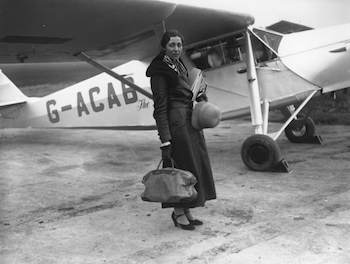
Amy Johnson stands in front of her plane at Stag Lane Aerodrome before her record-breaking flight to South Africa and back. (Getty)
Amy Johnson was a truly remarkable woman. There’s a trail of moths in celebration of her around her hometown of Kingston-upon-Hull at the moment. But why?
Well, the trail and the Amy Johnson Festival are all to celebrate her life and her amazing achievement as a pioneering aviatrix. In 1930, she was the first woman to fly solo from England to Australia, and following that, she broke a string of other records. The moths are to commemorate the Gipsy Moth biplane that she used on her amazing 11,000-mile journey.
Born in 1903, Amy Johnson grew up in Hull, where her father was in the fishing industry. She studied economics at Sheffield University, and began to work in London at a solicitors firm. One afternoon she chanced upon a north London Aerodrome, and, instantly interested in the planes, she began to work towards getting a pilots licence as a hobby.

Image from the Amy Johnson Festival
Women flying planes was not so unusual at the time, but it was mainly the preserve of upper-class women with lots of time and money to spare. (This didn’t stop some newspapers from speculating about all of the clothes Amy must have brought with her on flights!) Amy had not grown up in such a well-off family, but her father helped her pay for her pilot’s licence, and her Gipsy Moth plane (that she named ‘Jason’) and soon she was flying around the country.
In 1930, Amy received worldwide recognition for becoming the first woman to fly solo to Australia. She took off on May 5th and landed on May 24th. She had had to stop every few hundred miles to refuel, and as she had plotted the most direct route possible, this meant refuelling in some pretty inhospitable places!
Amy’s amazingly skilled feat meant she rose to instant fame. In the 1930s, songs and stories were written about her, and she became a style icon. Following a whirlwind romance with another pilot, Jim Mollison, who she married in 1932, she went on to break more records, such as duo flights to South Africa, India and New York from England, all in record time.
In 1940, Amy joined the war effort as part of the Air Transport Auxiliary, which flew Royal Air Force planes around Britain to get them to the right air bases. It was on one of these runs that she mysteriously passed away. On January 5th 1941 she was due to fly from Blackpool to Oxford. Some hours later, however, a convoy of ships off the coast of Kent at Herne Bay spotted a plane going down, and a parachute going down into the water. Several sailors reported seeing two bodies in the water. The ships approached and a rescue was attempted, but in the icy seas it was not successful. Parts of Amy Johnson’s plane and possessions, including her notebook, washed up nearby.
What she was doing so far off course remains a mystery to this day. Had she simply got lost in the poor visibility of a snowy January day? Had she been part of a secret mission that had failed? Had she been shot down by friendly fire? As Amy’s body was never recovered, it is unlikely we will ever know the exact circumstances around her death. But we can know that she was a truly remarkable, plucky woman who should be remembered and celebrated.
-Jocelyn Anderson-Wood
Junior Girl
Girl Museum Inc.
Tags:
Amy Johnson, solo flying, first woman, Australia
